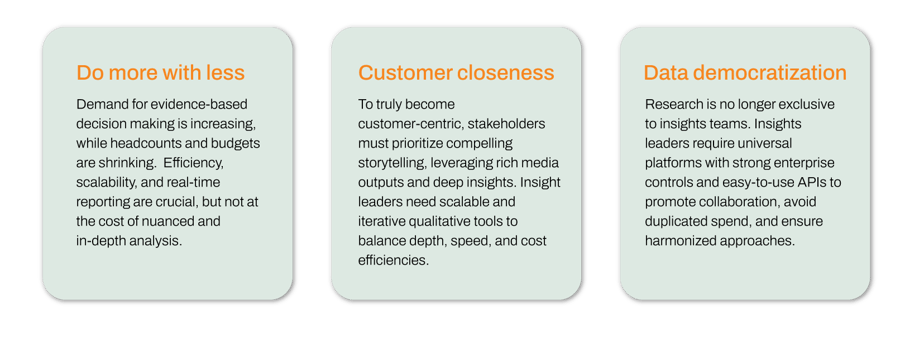As a well-established technology company with over 20 years’ experience, we’ve seen all sorts of challenges over the years. Today’s environment poses a unique set of challenges for customer-centric organizations:

This is why an insights ecosystem centered around a customer panel, often referred to as a community, continues to be the most efficient and effective way of driving deep insights at speed and scale. In an increasingly complex landscape, progressive insights leaders are turning to their communities, challenging preconceptions about how they can be used to drive strategic insights and scaling them across more use cases, more teams, and more markets.
But partnering with the wrong technology platform can hinder your ability to do scalable research with less. To elevate the strategic value of your insights efforts, you need a community platform that scales effectively with a robust back-end as well as the front-end features you’d expect. Software that is not built for scale also means you end up spending more on services. It’s time to ask yourself whether you are being held back by the technology you are currently using.
Here are 8 questions you should be asking yourself when selecting a research technology partner for your community to ensure you are set up for success:
1. Can you underpin the majority of your insights ecosystem with one platform?
In 2024, we are seeing a shift from community to insights platform. The community provides access to key audiences for rapid turnaround insights. But as platform spend is under scrutiny, the solution needs to deliver more - ultimately becoming a comprehensive universal solution. This could entail collecting data from diverse samples, utilizing preferred methodologies, integrating seamlessly with other tools as needed, and being accessible to various teams or agencies. Ultimately, the goal is to consolidate data within a unified analytics platform to streamline insights generation and decision-making processes.
2. Does your platform self-serve well with enterprise controls in place, or is a gatekeeper required?
If any aspect of your technology, whether it's research programming, deployment, or analytics, requires external services to derive value, then you're likely using the wrong platform. Teams are looking for the flexibility to be self-sufficient for quick-hit, agile research, with the ability to leverage hybrid services as and when they need them. Either way, communities must seamlessly integrate across the business, devoid of bottlenecks and clunky workflows, and should be intuitive and user-friendly. Enterprise controls should be in place to enable seamless collaboration between teams & stakeholders.
3. Does your platform have scalable qualitative tools which are built for researchers?
Zoom is not a research tool. As speed of getting insight into stakeholders hands becomes increasingly important, we are seeing an increase in the adoption of online qual methods like video capture, online IDIs, groups, and triads. Robust analytics capabilities powered by AI, including translation, transcription, and editing capabilities are a must for driving powerful storytelling at scale. Additionally, recent AI innovations in sentiment analysis are furthering research teams’ ability to scale their work for greater impact.
4. Are the APIs and integration capabilities actually easy to use?
When working with a research partner, many claim to be one platform through APIs, but they are often very difficult to use and don’t have a data lake to ensure all your data is readily available in one place. Without the proper support, integrated insights ecosystems can quickly become a pipe dream. Leading providers have a Centre of Excellence dedicated to integrations as well as comprehensive documentation and truly easy to use APIs.
5. Does your platform have a robust, self service reporting suite?
Centralized insights ecosystems will naturally require advanced reporting capabilities, yet so many solutions still find themselves lacking in this area. For example, not offering real time updates, not having multi source dashboards as well as survey reports, not being able to visualize data longitudinally. Often we hear about having to do multiple imports and exports to combine data sets or analyze them the way you want to, or even having to engage with the provider to get access to the data needed. Comprehensive and easy to use analytics is the key to scale as reporting needs become more complex and widespread.
6. Does your technology supplier have a strong, safe vision for AI?
For businesses with a digital presence (which encompasses most businesses today), AI will soon become essential for maintaining competitiveness. Many team leads are already grappling with the challenge of leveraging AI to drive efficiencies and enhance outputs. This includes built-in automation tools like alerts, reporting, scheduling, and real time dashboards powered by AI. This is where partnering with a dedicated technology provider proves advantageous compared to suppliers juggling both services and software—two often conflicting business models. Technology-focused firms possess the R&D budgets and resources necessary to develop a robust AI roadmap. Whether it involves simplifying analysis, optimizing community management, or leveraging synthetic data, among other capabilities, it's crucial to evaluate how your supplier approaches AI and addresses your privacy concerns.
7. Are there alternative ways to easily reach customers and non-customers?
As reliance on email diminishes, it becomes essential to utilize tools that enable reaching customers wherever they may be - such as directly in digital channels, or by leveraging non-community sample. This approach expands reach and yields more real-time insights, facilitating the optimization of digital journeys and offering a valuable supplementary data source for integration with behavioral data.
8. Are you supported by a proactive team focused on business value challenging you to do more?
It’s easy to get sucked into project management tasks without proactive support. Unlocking the true potential of your community requires significant change management. It is crucial to dedicate enough time to articulating the value of the program or finding new ways to grow that value. With the potential being so great, you need a partner and a dedicated customer success team focused on making you successful with the overall investment, delivering strategic business reviews used to inspire and guide your program maturity beyond the tactical tasks.
With so many different technology providers to choose from, ensuring you’re partnering with the right organization is the difference between overcoming the challenges of today’s market versus wasting money and cycles running in the wrong direction.
Ready to elevate your community to the next level? Check out our Community Best Practice Guide.








